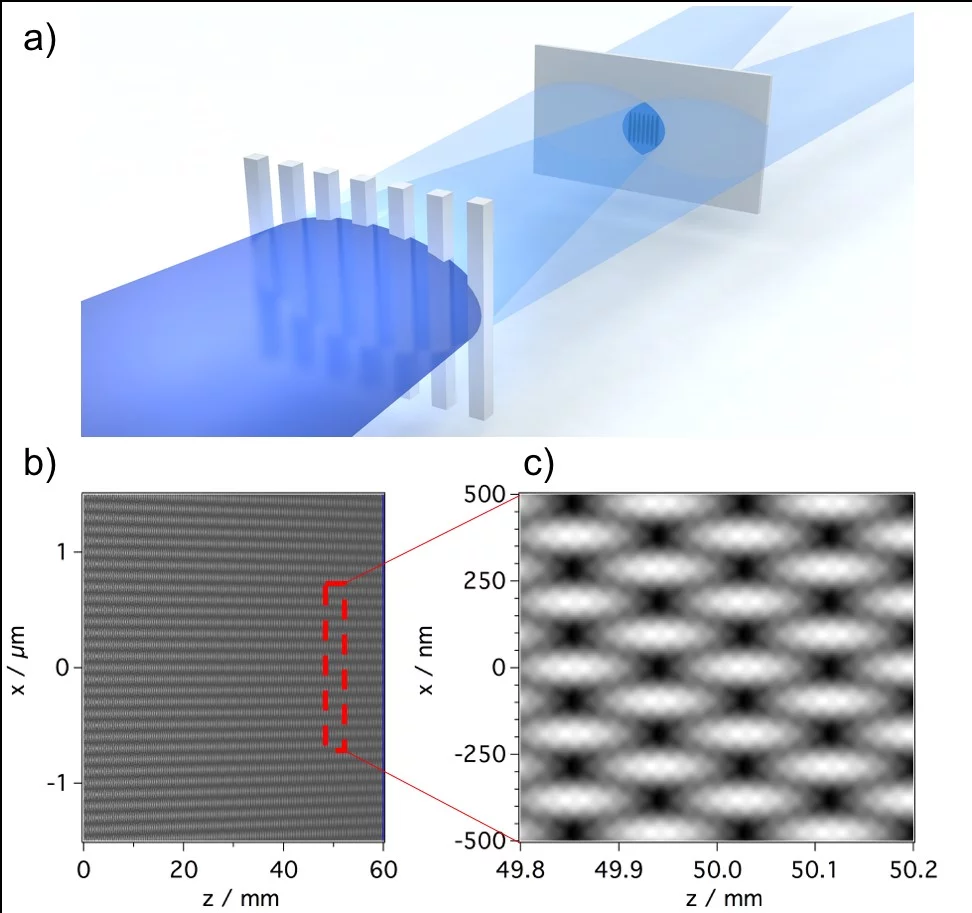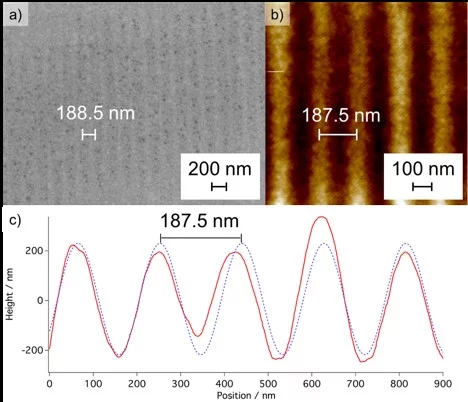Towards X-ray Transient Grating Spectroscopy at SwissFEL
The high brilliance of new X-ray sources such as X-ray Free Electron Laser opens the way to non-linear spectroscopies. These techniques can probe ultrafast matter dynamics that would otherwise be inaccessible. One of these techniques, Transient Grating, involves the creation of a transient excitation grating by crossing X-ray beams on the sample. Scientists at PSI have realized a demonstration of such crossing by using an innovative approach well suited for the hard X-ray regime. The results of their work at the Swiss Free Electron Laser have been published in the journal Optics Letters.
Non-linear optics is an important field of physics where the non-linear response of matter in extreme electromagnetic fields is studied and exploited for novel applications. It has been widely used for creating new laser wavelengths (Sum/Difference Frequency Generation - S/DFG) as well as for studying a variety of properties such as charge, spin, magnetic transfer as well as heat diffusion. A broad class of non-linear spectroscopy is Four Wave Mixing (FWM) where three laser beams are overlapped in space and time in a sample and a fourth beam with different wavelength and angle is detected, background free. This allows studying specific transitions and selectively excite the sample tuning the incoming beams’ wavelength while studying their dynamics by controlling the relative time delays between the laser pulses. Transient Grating (TG) spectroscopy is a special case of degenerate FWM where two of the incoming beams have the same wavelength and are crossed at the sample creating an interference pattern, or transient grating, which excites the sample as long as the field is present. When the TG impinges on the material, its index of refraction is locally perturbed and electrons exposed to the radiation are excited. These electrons then transfer their extra energy to the lattice and the heat is then dissipated by the system. A third beam, delayed with respect to the pump TG, probes the dynamics of this excitation.
In a joint effort, scientists from the SwissFEL Alvra and Bernina experimental stations (C. Svetina (PI), R. Mankowsky, G. Knopp, C. Cirelli, C. Pradervand, B. Pedrini, S. Zerdane, V. Esposito, M. Beck, G. Ingold, C. Milne, H. T. Lemke, and P. Beaud), the Laboratory for Micro and Nanotechnology (F. Koch, G. Seniutinas, B. Rösner, A. Kubec, M. Lebugle, I. Mochi, C. David), the Optics group (J. Krempasky, U. Wagner, R. Follath, U. Flechsig) and EPFL-LSU ( J. Rouxel, G. F. Mancini, M. Chergui), have tested a new method for generating periodic gratings at XFELs by exploiting the Talbot effect of a convergent beam while working out of focus (Fig.1) exploiting diamond phase gratings (Fig.2). In order to validate the technique, they have generated XTGs with period of 187 nm on gold and spin-coated polymethyl methacrylate (PMMA) at the SwissFEL Alvra instrument at 3 keV with single and multiple shots. By exceeding the damage threshold of the materials they have printed interference patterns which were then measured by means of a Scanning Electron Microscope (SEM) and Atomic Force Microscope (Fig.2a-2b) confirming the theoretical calculations and demonstrating the reliability of the method.
This important result has demonstrated the feasibility of generating XTG at SwissFEL and XFELs in general. By focusing closer to the sample, the period of the grating can be decreased down to a few tens of nanometers allowing the study of thermal transport in the ballistic regime, which will enable researchers to answer some open questions regarding how heat diffuses at the nanoscale, which is currently a limiting factor in the miniaturization of electronic devices. In addition, tuning the pulses to be resonant to specific elements in the material will enable the study of propagation of wave packets between different elemental sites in the materials.
Right now, the team is preparing for the very first time-resolved XTG pump – optical probe experiment on Diamond and other systems at the Bernina SwissFEL experimental station. The main goal will be to study heat diffusion, as well as the initial ultrafast excitation mechanisms. The ultimate goal will be to be able to perform full XTG experiments: X-ray pump – X-ray probe, which, has long been of interest for a variety of fields of research, and will open exciting new opportunities for science at XFELs. The reported results have been recently published (C. Svetina et al., Optics Letters 44 I3, 2019, https://doi.org/10.1364/OL.44.000574)
Contact person: Cristian Svetina (cristian.svetina@psi.ch)
In a joint effort, scientists from the SwissFEL Alvra and Bernina experimental stations (C. Svetina (PI), R. Mankowsky, G. Knopp, C. Cirelli, C. Pradervand, B. Pedrini, S. Zerdane, V. Esposito, M. Beck, G. Ingold, C. Milne, H. T. Lemke, and P. Beaud), the Laboratory for Micro and Nanotechnology (F. Koch, G. Seniutinas, B. Rösner, A. Kubec, M. Lebugle, I. Mochi, C. David), the Optics group (J. Krempasky, U. Wagner, R. Follath, U. Flechsig) and EPFL-LSU ( J. Rouxel, G. F. Mancini, M. Chergui), have tested a new method for generating periodic gratings at XFELs by exploiting the Talbot effect of a convergent beam while working out of focus (Fig.1) exploiting diamond phase gratings (Fig.2). In order to validate the technique, they have generated XTGs with period of 187 nm on gold and spin-coated polymethyl methacrylate (PMMA) at the SwissFEL Alvra instrument at 3 keV with single and multiple shots. By exceeding the damage threshold of the materials they have printed interference patterns which were then measured by means of a Scanning Electron Microscope (SEM) and Atomic Force Microscope (Fig.2a-2b) confirming the theoretical calculations and demonstrating the reliability of the method.
This important result has demonstrated the feasibility of generating XTG at SwissFEL and XFELs in general. By focusing closer to the sample, the period of the grating can be decreased down to a few tens of nanometers allowing the study of thermal transport in the ballistic regime, which will enable researchers to answer some open questions regarding how heat diffuses at the nanoscale, which is currently a limiting factor in the miniaturization of electronic devices. In addition, tuning the pulses to be resonant to specific elements in the material will enable the study of propagation of wave packets between different elemental sites in the materials.
Right now, the team is preparing for the very first time-resolved XTG pump – optical probe experiment on Diamond and other systems at the Bernina SwissFEL experimental station. The main goal will be to study heat diffusion, as well as the initial ultrafast excitation mechanisms. The ultimate goal will be to be able to perform full XTG experiments: X-ray pump – X-ray probe, which, has long been of interest for a variety of fields of research, and will open exciting new opportunities for science at XFELs. The reported results have been recently published (C. Svetina et al., Optics Letters 44 I3, 2019, https://doi.org/10.1364/OL.44.000574)
Contact person: Cristian Svetina (cristian.svetina@psi.ch)




